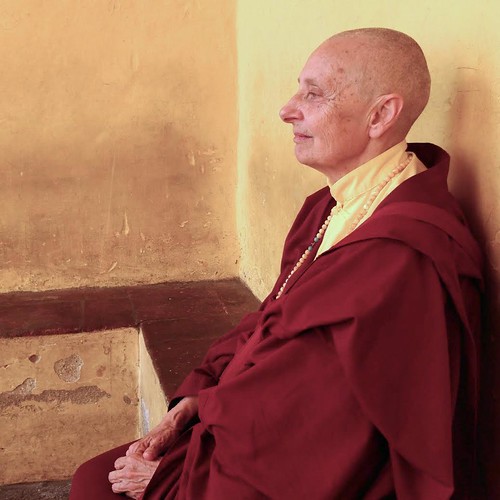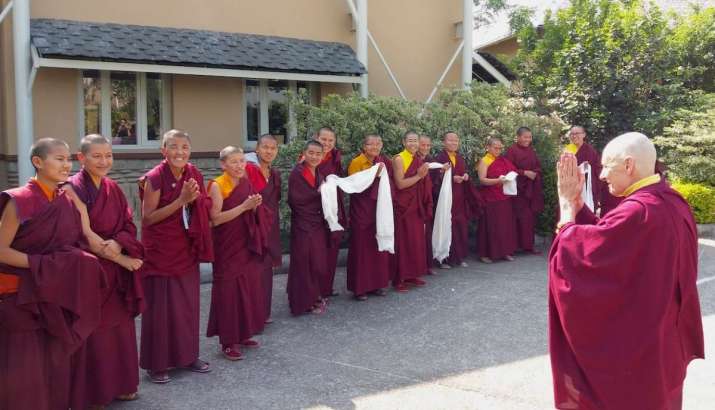For nearly 20 years, Jetsunma Tenzin Palmo has been visiting the United States, offering compassion, teachings, and refuge to practitioners across the country. I interviewed Jetsunma on the eve of her most recent US tour, which runs from June to July this year.

Buddhistdoor Global: Jetsunma, in thinking about the growth of Buddhism in the US, what should be done to increase our awareness of the fourfold sangha?
Jetsunma Tenzin Palmo: Honestly Harsha, it’s been a problem not just in the US, but throughout the Western world. In Asia the lack of balance was toward the fact that in the fourfold sangha the monastic sangha was the most important, especially the monks. The role of laypeople was mostly to make merit and support the monks. Nowadays in the West, it’s gone the other way, as you know, and the monastic sangha is diminutive and of very little importance compared with the lay sangha.
Most of the teachers and, of course, the students are laypeople. And this is a good thing in some ways; it’s right—the Buddha’s intention was that both the monastic and lay sanghas should study, practice, and propagate the Dharma, not only the monks. But it’s gone too much the other way and there is a lack of appreciation for monasticism—not just in America but in the Western world in general.
It’s very difficult to know how to deal with that. Many women ordain, especially in the Tibetan tradition, after having had a fairly successful life, professionally and in personal relationships, and they feel they need to really dedicate their lives to their studies and their Dharma practice. But when they are ordained, they discover that there is simply no support system in the Tibetan traditions. The Tibetans consider all Westerners to be affluent with their own sources of financial support, so it doesn’t occur to them to offer to help.
Conversely, laypeople assume that [female monastics] are being supported by their organizations or by their lamas, and while they are vey happy to support Tibetans, they never consider supporting their own. So people struggle, and not just financially but also psychologically. If you become a monastic, people often ask, “What are you escaping from?” Nobody would ask a lama, “What’s your problem?” Yet they assume that it must be because they couldn’t face reality, whatever that means. So there is no respect there, or appreciation for what monastics are trying to do, or admiration for people who are trying to lead a life based on simplicity, renunciation, and so forth.
As a result, they don’t fit in anywhere—they don’t fit in Asia with the Tibetans, and they don’t fit in with modern Western society. They feel very alienated and disheartened, basically. There is no training, very little, I mean. The American nun and teacher Thubten Chodron is doing wonderful work at Sravasti Abbey in Washington State to try to create a vibrant monastic community, but still that is small and it’s impact is not immediately felt in all Buddhist circles. Certainly, it’s hard and I don’t know what the solution is.
BDG: Jetsunma, you have been very active and dedicated, in particular to the Alliance of Non Himalayan Nuns. Could share a little bit about its genesis and how you see it going forward?
JTP: Well, this has become such a problem—not just for Westerners, but also for other Asians being ordained into the Tibetan tradition. Chinese, Vietnamese, Koreans who choose to be ordained in Tibetan lineages automatically cut themselves off from the supply channels they would have had if they were within their own Mahayana system, so they don’t belong anywhere. They don’t belong in their own countries, to the Buddhism in their own countries, and they are not supported in any way by the Tibetans, who are very inward-looking toward their own people and not really sympathetic to others coming from outside. Therefore, because we meet these nuns of East and West who feel so lost and unappreciated, who want to do courses or go for meditation, and can’t afford to because even for Dharma courses they charge the monastic sangha the same as laypeople.
We thought we would try to do something to make people more conscious, that there are these monastics, especially nuns, within their midst who are not being supported in any way, because normally they would never talk about it. In fact, sometimes they are in denial because the feel that if they mention that they are struggling, it will be in some way a negative comment on their teachers. So we started the Alliance of Non Himalayan Nuns.
Himalayan nuns now are doing quite well—there are nunneries, there are training programs, and people are appreciating the input of nuns. Even within Tibetan society, the status of nuns is rising as they become more educated and more qualified in rituals and so forth. They are being more appreciated because they keep very good discipline. But at the same time, it doesn’t help all those nuns who are not Himalayan. So we started this alliance to try to bring more awareness to the situation and to try to raise some funding so that we can help nuns who want to study, and undertake retreats, and so forth.
Recently someone gave money for any nuns that needed robes, so in this way we try to create on the side of laypeople an awareness of the needs of the nuns. For the nuns, they know there is at least somebody who cares about them. Our other aim is to try to bring some of the more isolated nuns into contact with each other, even via cyberspace, so that they can video call each other or chat, just to know that there are other people out there who are experiencing the same problems and that they are not alone.
A lot of nuns disrobe simply because they get disheartened. They just feel so lonely, they don’t belong anywhere, and they give up. They don’t give up the Dharma, but they give up monastic life. The Buddha’s intention was that there should be a community, a sangha, yet most of them are just so isolated.
It’s a hard one, you know, because the Buddha’s intention was to have the fourfold sangha, supporting each other, with the monastics through their study, and their total dedication, and their practice, being there to help and teach and be an example for laypeople, who likewise are going to be studying and practicing. I mean, that was the idea, that both sides would help each other. But it has a little bit fallen to extremes.
BDG: I recently heard a talk by Dzongsar Khyentse Rinpoche in which he was talking about Buddhism coming to the West and how it came in a rather unique fashion, particularly compared with Asia, where it was often a state-sponsored religion. He said that there has never really been a Buddhist mission here, and I wonder if there should have been. I was reflecting that it might help correct some of these imbalances and whether, with this sort of erratic transmission, people are really holding to the original tenets of the Buddha?
JTP: I think that is true. There was never one big wave where it was taken up by a king and propagated officially, with people encouraged to take refuge. It’s always been that somebody comes and starts a little center here, and then somebody else comes and brings another variety of Buddhism, and starts another center there.
For example, in London in the early 1960s when I first became a Buddhist, the only two were the Buddhist Society, which was run by a man called Christmas Humphreys and these kind of nice middle-class ladies. Then there was the Sri Lankan vihara, which was more traditional and very Theravada, but even when the Theravadans came, or the Tibetans, they still had to tailor what they were teaching to the interests and abilities of the audience they were facing.
It’s been a learning process because their audiences are laypeople, not monks. Highly educated laypeople who don’t just want to be told how to make merit, but want the whole path given to them. They don’t often have much time to actually dedicate to realizing it, so this has been the challenge for all traditions. Of course, in every country to which the Buddhadharma spread from India, they took the part that suited their culture and left other parts quietly in abeyance. In China, Sri Lanka, Thailand, Tibet they took those parts that were helpful for them and left aside other parts.
In the West it has been very clearly indicated that so many teachers teach a very circumscribed form of Buddhism, leaving out all the bits that they think might push people’s buttons. This is actually something of a danger, I think, because it’s creating this idea that Buddhism is just meditation, which it isn’t. I mean, meditation is part of it, but it’s not the whole path.
There’s also this sense that it’s about making transformations just for this lifetime and that’s it—a very scientific, materialist view that is not in any way in accordance with any of the sutras, either Theravada or Mahayana. They never give the idea that there is this whole vast panorama of time and space, and the many realms of being that interconnect with our own and which we aren’t normally aware of with our paltry five senses. It shrivels the Dharma into a very comfortable package and leaves out so much of what makes the Buddhadharma unique.

BDG: Jetsunma, you know that American Buddhism is not a monolith, but in terms of moving forward, what should we be focused on? Is it a matter of educating ourselves more in Buddhist history? Is it connecting more deeply with the living tradition around us? What can we do?
JTP: I think it is important to look at other aspects of Buddhism, apart from just meditation. Understanding the mind, taming the mind, transcending the mind is the crux of the matter, but it’s not all that there is. I think that an appreciation of all the other aspects is very important. To really understand Buddhist philosophy, not necessarily logic, and Madhyamaka, and so forth, but at least to under the whole Jnana paramita, and all these other qualities, such as ethics, and generosity, and patience, and loving kindness, and compassion, and a clear understanding of karma and rebirth, and the whole picture of why we are where we are, doing what we are doing, and why things happen, and how to respond skillfully. I mean Buddhism is vast and it seems very sad to me to make it just a form of feel-good therapy.
BDG: Could that come in the form of more Buddhist institutions, teachers stepping up, or sending teachers from Asia? I know it could be all of those things, but Jetsunma, with your tremendous wisdom and magnanimous compassion, I just want to take away a vision that we could help support or work toward, if there could be said to be such a thing.
JTP: Well, it’s difficult because each country, each culture created the Buddhism that was suitable for them, and so you cannot say there is on overreaching Buddhadharma that is suitable for everybody. One of the beauties of the Dharma is that it has so many different aspects, so many facets, so many different emphases. And so you can’t think, “This is it, this is the true Dharma, and everybody else is missing the plot.” But I do think it would be good to lay some emphasis on these other aspects of the Buddhadharma, such as social responsibility, ethics, patience, and so forth—an appreciation that there is so much out there for us to understand; that if we come across a doctrine toward which we feel an inner resistance, not to reject it because it doesn’t fit our own preconceptions.
To say, “I don’t believe this, therefore the Buddha didn’t teach it,” is enormous arrogance. My lama taught me that if I came across something that I really didn’t believe, just to put it aside and go back to it later when I have studied more. He himself said that not everything that is written in books is true, but nonetheless we shouldn’t be too quick to throw out everything just because it doesn’t fit with what I personally believe. I mean, we are trying to change our thinking, not change the Dharma to suit our thinking.
To have a much broader, more open mind, it is very important for Buddhists in the West to recognize that the Dharma is huge and to read some really authoritative books by genuine scholars and practitioners. Not just the new-agey stuff. This is always the problem—the Buddha never intended it to be a feel-good therapy, it’s supposed to push your buttons.
See more
Dongyu Gatsal Ling Nunnery
The Alliance of Non Himalayan Nuns
Dongyu Gatsal Ling Initiatives













